Decoding your prospect's buying decision mode
January 23, 2018
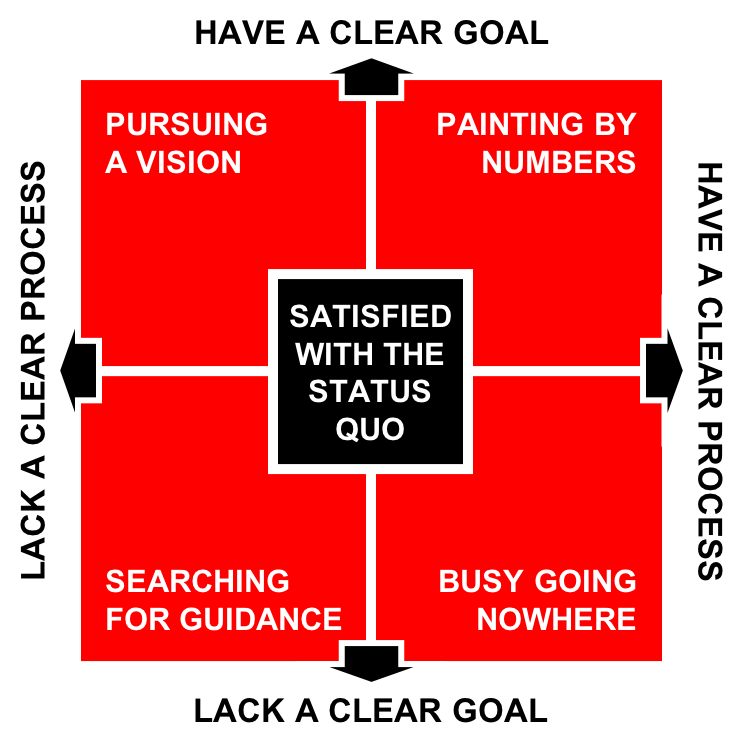
Are your prospects Satisfied with the Status Quo, Painting by Numbers, Pursuing a Vision, Busy Going Nowhere or Searching for Guidance?
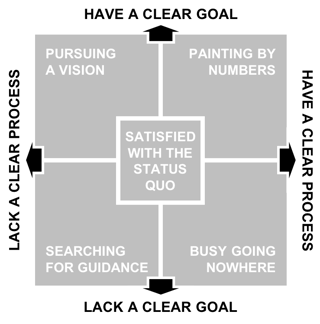 I recently wrote about the phases B2B prospects tend to go through as their buying decision process evolves, and the need to align our sales and marketing tactics accordingly. Of course, our prospect’s journey is rarely linear: at any point they can choose to move forwards, revert to a previous phase, go around in circles, put the project on hold, or abandon the journey altogether.
I recently wrote about the phases B2B prospects tend to go through as their buying decision process evolves, and the need to align our sales and marketing tactics accordingly. Of course, our prospect’s journey is rarely linear: at any point they can choose to move forwards, revert to a previous phase, go around in circles, put the project on hold, or abandon the journey altogether.
But the phase our prospect has reached in their buying journey isn't the only thing we need to be aware of when it comes to understanding their likely buying behaviour: we also need to determine whether or not they have a clear goal in mind, and whether or not they have a clear process for deciding how to achieve that goal.
This isn’t as crazy as you might think: one of the primary reasons that so many buying journeys end in “no decision” is that the exercise either lacked a clear goal, or a clear buying decision process, or both. Or the ultimate decision makers in the customer might actually have been satisfied with the status quo all along…
5 POTENTIAL BUYING MODES
It’s helpful to visualise these combinations as a classic 4-box matrix. Along one axis, we assess whether or not the prospect has a clear goal, and along the other whether or not the prospect has a clear process. And just to complete matters, let’s park “satisfied with the status quo” in the centre of the picture.
That gives us 5 potential options:
- Despite appearances, our prospect might actually be Satisfied with the Status Quo
- Our prospect might have a clear goal and a clear process. Let’s call this mode “Painting by Numbers”
- Our prospect might have a clear goal but lack a clear process. Let’s call this mode “Pursuing a Vision”
- Our prospect might have a clear process but lack a clear goal. Let’s call this mode “Busy Going Nowhere”
- Finally, our prospect might lack a clear goal or a clear process. Let’s call this mode “Searching for Guidance”
As you can imagine, these five different buying modes drive five very different buying behaviours, and we need to respond by adopting appropriately different sales strategies and behaviours. Let’s consider the implications of each.
SATISFIED WITH THE STATUS QUO
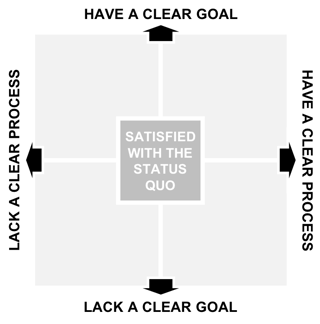 In this mode, the prospect isn’t actually convinced of the need for change but is nevertheless going through what appear to be a set of buying motions. Sometimes this happens because the instigator of the buying process is simply curious about what is out there, and/or has an unhealthy amount of time on their hands to follow trivial pursuits.
In this mode, the prospect isn’t actually convinced of the need for change but is nevertheless going through what appear to be a set of buying motions. Sometimes this happens because the instigator of the buying process is simply curious about what is out there, and/or has an unhealthy amount of time on their hands to follow trivial pursuits.
Or, the prospect may be happy with an existing supplier, and intends to retain them, but is seeking alternative competitive quotes in order to beat them down on price. Unless we can persuade them to change their decision criteria, which are usually heavily biased in favour of the incumbent, we are on a hiding to nothing.
Some of the indicators include a lack of serious interest in the details of the competing solutions, being given a short time frame to respond, and/or a refusal to grant access to either the ultimate decision maker or the business problem owner.
Whether the project turns out to be a trivial pursuit or a hiding to nothing, there is little we can do other than waste our time unless we can persuade the prospect to change their parameters. If we can’t, the only sensible thing is to politely qualify out early - and if we are feeling particularly mischievous and wish to do the incumbent harm make sure we submit an outrageously low-balled indicative response (as opposed to a binding quote) before we do so.
PAINTING BY NUMBERS
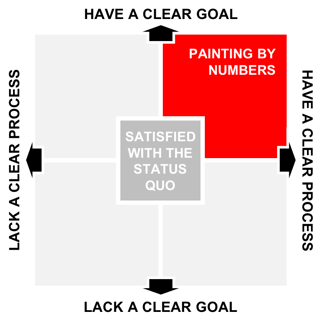 When our prospects believe they know both what they want to achieve (where) and how they are going to achieve it, they are in what we call “painting by numbers” mode. They have a very clear specification of what they want to buy, and they have a very well-defined process for how they are going to make the buying decision. This mode is particularly common where an organisation is buying a well-defined commodity or raw material on a repetitive basis.
When our prospects believe they know both what they want to achieve (where) and how they are going to achieve it, they are in what we call “painting by numbers” mode. They have a very clear specification of what they want to buy, and they have a very well-defined process for how they are going to make the buying decision. This mode is particularly common where an organisation is buying a well-defined commodity or raw material on a repetitive basis.
Some of the indicators include inviting vendors to participate late in the cycle, typically through the issuing of an often-unexpected RFP. This may be the first time we're aware of the project, but the buyer is already a long way through their buying decision process already. They are on a mission, and in no mood to be diverted.
Unless we can reframe either the process or the goal, our chances of winning primarily depend on our ability to offer the best price, delivery and contractual terms against the specification that has already been established by the customer. If we can’t change the game, we either have to play by their rules or chose to walk away.
If we choose to compete, this usually turns into a painful and expensive process for any vendor that isn't in the driving seat when it comes to influencing the prospect's specification. If sales people fail to recognise that they are involved in a "paint by numbers" project, they can waste an incredible amount of both their selling time and their colleague’s valuable resources. Don’t let them.
PURSUING A VISION
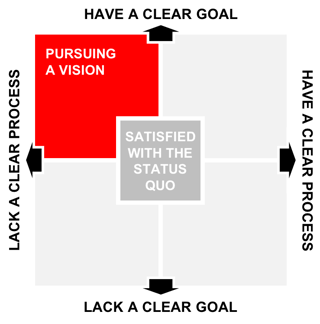 In this mode, the prospect has a clear goal but lacks a clear process for deciding how best to achieve it. Assuming that we can also work with the prospect to create a significant value gap between their current situation and their desired future position, these projects give us a tremendous opportunity to shape the prospect’s thinking.
In this mode, the prospect has a clear goal but lacks a clear process for deciding how best to achieve it. Assuming that we can also work with the prospect to create a significant value gap between their current situation and their desired future position, these projects give us a tremendous opportunity to shape the prospect’s thinking.
Our prospect is on a mission to change things. They have a vision of where they want to get to. But their maps - which ought to show them how to get there - have large blank areas with labels like “unexplored territory” or even (depending on the vendors they choose to call in for advice) “here be dragons”.
Some of the indicators include a clear vision of what they believe they need to achieve, combined with an openness to consider any and all credible means to achieve their goal. They will be as or more interested in what is different about our knowledge of the problem and our approach to solving it as in the fine details of our solution.
This is an excellent opportunity for us to implement our value selling and consultative sales skills. We have the opportunity to fill in the gaps in the terrain, to help them think differently about their options, to offer them a roadmap and to show them the way forward.
If we've got a smart sales team, supported by an intelligent marketing organisation, they ought to relish these "pursuing a vision" projects. They give us a real chance to establish our thought leadership, and to distinctively differentiate our approach - so the challenge is to find more of them, by engaging with the prospect before they have worked out how to solve an urgent problem.
BUSY GOING NOWHERE
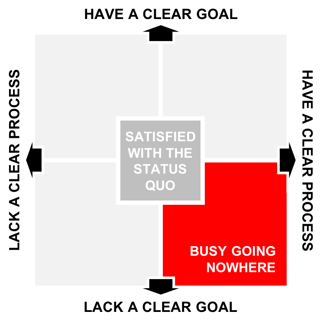 Or maybe the reverse is true - our prospects, although they are dissatisfied with the status quo, are unclear about what they need to change to (where) or what success would look like and are shackled by a rigid procurement process that dictates how they are going to make the buying decision. We can think of these prospects as “Busy Going Nowhere”.
Or maybe the reverse is true - our prospects, although they are dissatisfied with the status quo, are unclear about what they need to change to (where) or what success would look like and are shackled by a rigid procurement process that dictates how they are going to make the buying decision. We can think of these prospects as “Busy Going Nowhere”.
They are confined by an often-bureaucratic procurement process that they either cannot break away from or do not wish to escape, but when questioned seem to lack a clear or coherent vision of what success would look like once the buying process has come to a conclusion.
Some of the indicators include Kafkaesque “we’re doing it this way because we’re doing it this way” conversations with functionaries who are self-evidently not the ultimate business problem owners, combined with an inability to get to the heart of the underlying business drivers.
Like “painting by numbers”, this mode is often associated with the receipt of an unanticipated RFP. If you sense that your prospect may be in “busy going nowhere” mode - and in particular if you have no opportunity to reshape their vision or influence their decision process - you need to think very carefully whether you want to waste your sales resources on the project.
These can be horrible and frustrating opportunities to work on. I'm told that some public procurement projects have these characteristics. We need to get to someone senior enough to be able to reshape their thinking about what they are trying to achieve. If we can't, even if we win, we can probably count on a painful and protracted negotiation process and an equally painful and profit-free implementation.
SEARCHING FOR GUIDANCE
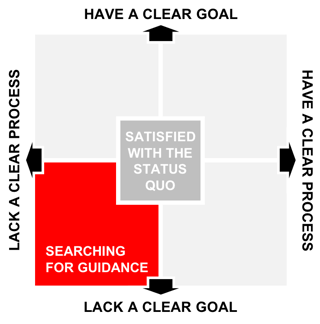 Last, but by no means least likely, our prospect may know that they need to change but they have no clear idea of what they need to change to or how they are going to get there. Our prospect is often reacting to a recent trigger event or tipping point that has made continuing with the status quo untenable. They know they need to change - but they are not yet sure what they need to change to.
Last, but by no means least likely, our prospect may know that they need to change but they have no clear idea of what they need to change to or how they are going to get there. Our prospect is often reacting to a recent trigger event or tipping point that has made continuing with the status quo untenable. They know they need to change - but they are not yet sure what they need to change to.
This is another golden opportunity to exercise our value selling and consultative selling skills. Our objective must be to help them shape a vision of what they could accomplish, as well as holding their hand on the journey towards their destination. These situations often represent a real opportunity to demonstrate the full value we could bring to them.
The first thing we need to do if we encounter a one of these projects is to make sure that the prospect sees a real need to change. We need to highlight the cost and consequences of inaction to them, illustrate the alternatives available to them, and start - right from this early stage - to lead their thinking in the direction of our strongest, most relevant capabilities.
Just as when prospects are “pursuing a vision”, these “searching for guidance” projects give us a real chance to establish our thought leadership, to stand out from the crowd, and to distinctively differentiate our approach.
Some sales people may be concerned that these could turn out to be lengthy sales cycles, but they do not have to be: if we find ourselves talking direct to the business problem owner, if we can build their trust, if we can help to recognise the urgent need for change, if we can work with them to shape a compelling vision of their solution and if we can convince them that we are the right partner to guide them on their journey, these opportunities can often move swiftly to a conclusion.
5 DISTINCTIVELY DIFFERENT STATES
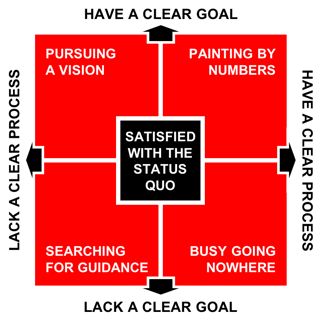 So, there we have it: the five distinctively different potential buying decision modes. The mode our prospect is currently in will significantly influence their behaviour - and knowing which mode they are in must influence our approach to dealing with them. Of course, once we’ve diagnosed their current mode, it may be possible - with a focused effort - to move a prospect from one mode to another that is more favourable to us.
So, there we have it: the five distinctively different potential buying decision modes. The mode our prospect is currently in will significantly influence their behaviour - and knowing which mode they are in must influence our approach to dealing with them. Of course, once we’ve diagnosed their current mode, it may be possible - with a focused effort - to move a prospect from one mode to another that is more favourable to us.
How well do you currently understand which mode each of your current prospects are in - and if that is unclear, what are you going to do to determine their true buying mode ? But even more important than that, once you’ve worked it out, what are you going to do about it? How are you going to adapt your strategies?
RECOMMENDATIONS FOR SALES LEADERS
You're probably used to asking your sales people what stage their opportunities are at. Hopefully, you've already got them thinking about the stage the prospect has reached in their buying decision journey, and not just about the stage the sales person has reached in their sales process, which as we know can be a completely different (and frequently more optimistic) matter.
This idea of buying "modes" is probably new to them and maybe also to you. But I'd strongly encourage you to explain these different modes to your sales people and ask them to position each of the deals they are working on against these 5 categories.
If - as might often be the case - their buying mode is either unclear or isn't very favourable, you can strategise with them to either work out how to reframe the prospect's thinking or recognise that, since you're probably going to lose, you might as well qualify out early.
I'd like to pay tribute to the brilliant Eddie Obeng of Pentacle the Virtual Business School, creator of Qube for inspiring this article. He was just a little more creative in naming the modes. In addition to “painting by numbers”, he called them “the quest for the grail”, “running around like headless chickens” and “lost in the fog”. I wonder if you can match them up with my slightly less colourful equivalents?
IF YOU LIKED THIS, YOU'LL PROBABLY ALSO APPRECIATE:
BLOG: Creating a new axis for SPIN® Selling
BLOG: Self-awareness and self-honesty in complex B2B sales
BLOG: We need to collectively develop sales competencies
BLOG: Where is your prospect in their buying journey?
WEBINAR: Selling in the Breakthrough Zone
DOWNLOAD: Our Guide to the Value Selling System
DOWNLOAD: 12-Point Value Selling Self-Assessment
ABOUT THE AUTHOR
 Bob Apollo is a Fellow of the Association of Professional Sales and the founder of UK-based Inflexion-Point Strategy Partners, home of the Value Selling System®. Following a successful career spanning start-ups, scale-ups and corporates, Bob now works with a growing client base of tech-based B2B-focused high-growth businesses, enabling them to progressively create, capture and confirm their unique value in every customer interaction.
Bob Apollo is a Fellow of the Association of Professional Sales and the founder of UK-based Inflexion-Point Strategy Partners, home of the Value Selling System®. Following a successful career spanning start-ups, scale-ups and corporates, Bob now works with a growing client base of tech-based B2B-focused high-growth businesses, enabling them to progressively create, capture and confirm their unique value in every customer interaction.


Comments